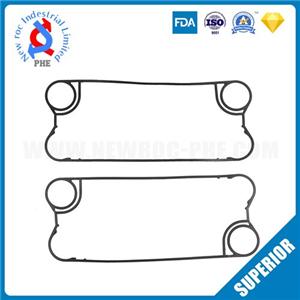Accounting measures of plate heat exchanger
Plate heat exchanger of accounting is a complex process, is now compared with popular way in logarithmic uniform temperature difference method and the NTU method.In accounting machine not in time, each manufacturer calculation parameter is chosen mostly approximate budget and the budgets of velocity – total heat transfer coefficient curve method.Now, keep adding manufacturers choose accounting, accounting machine so that the plate heat exchanger technology accounting become convenient, convenient and accurate.The following briefly illustrate common accounting method without phase change when the plate heat exchanger, the method is based on the principle of heat transfer and pressure drop correlation type is the root of the planning method.
The following five parameters in plate heat exchanger is necessary in the selection of accounting:
1.the total heat transfer (unit: kW).
2.The import and export of primary side and secondary side temperature
3.The primary side and secondary side promised to pressure drop
4.the highest working temperature
5.Maximum working pressure
6.If known to the flow of heating medium, specific heat and import and export temperature difference, the total heat transfer can be concluded.
The temperature
T1 = hot side inlet temperature
T2 = outlet temperature of the hot side
T1 = cold side inlet temperature
T2 = cold side outlet temperature
Heat load
Heat flow equation of equilibrium reflects the fluid in the relationship of the heat transfer in the process of temperature change, outstanding in heat exchanger heat preservation, under the condition of no heat loss, about the steady state heat transfer process, the heat flow balance relations as follows:
Heat flow (hot fluid released) = (cold fluid absorption heat flow)
In the heat balance of with and without phase change heat transfer process of its expression.
(1) no phase change heat transfer process
Type in the
Q – cold fluid absorption or hot fluid emits heat flow, W.
Mh, MC — — — — — hot and cold fluid mass flow rate, kg/s.
Cph, Cpc — — — — — – hot and cold fluid than constant pressure heat capacity, kJ/(kg · K);
T1, T1 — — — — — – hot and cold fluid inlet temperature, K;
T2, T2 — — — — — — hot and cold fluid outlet temperature, K.
(2) has a phase change heat transfer process
Two logistics in the process of heat transfer, during which a side logistics attack phase change, such as steam condensation or liquid exult, the heat flow value formula is:
On one side of the phase change
On both sides of the logistics are attack phase change, such as on one side of the condensation process of heat transfer in the other side exult
Type in the
R, r1, r2 — — — — — — — — logistics phase change heat, J/kg;
D, D1, D2 — — — — — — — — phase transformation through put, kg/s.
About overheating too cold or logistics attack phase change heat flow calculation, should be in accordance with the above way to add segments and accounting.
Logarithmic uniform temperature difference (LMTD)
Upstream: And when the flow:
Long and hot side temperature difference and logarithmic phase homogeneous temperature difference.F = dt/LMTD
The following four medium the influence of the physical properties of heat transfer
The density, viscosity, specific heat, coefficient of thermal conductivity
The total heat transfer coefficient
Pressure drop
Dirt coefficient
Accounting measures
Under thermal load can be used that states:
Q = m · cp · dt
Q = k · A · LMTD
Q = heat load (kW)
M = mass flow rate (kg/s)
Cp = specific heat (kJ/kg ℃)
The import and export of dt = medium temperature (℃)
K = total heat transfer coefficient (W/m2 ℃)





